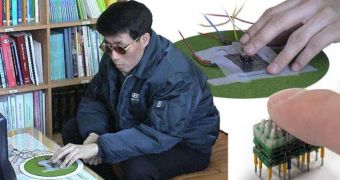The Braille system is one of the most reliable methods of communication between people who can see and those who can't. It relies on the blind touching a series of elevated dots, which dictate what letter or number they “see.” While books written in this language have been around for quite some time, experts have been trying to create a refreshable Braille display, which would be similar to a computer screen. Larger amounts of data could be stored within it, and the large, cumbersome books that blind people now have to use in order to read could become a thing of the past. That goal is now a little closer.
According to experts at the NASA-operated Jet Propulsion Laboratory (JPL), in Pasadena, California, artificial muscles could be one possible answer to the problems associated with creating such a display. “I hope that sometime in the future we will have Braille on an iPhone. It will be portable and able to project a picture of a neighborhood popping up in front of you in the form of raised dots. A digital Braille operated by artificial muscles could provide for rapid information exchange, such as e-mail, text messaging and access to the web and other electronic databases or archives,” explains Yosi-Bar Cohen.
Cohen is the JPL senior researcher who first came up with the Braille display idea. He says that, while on a business trip to Washington DC, he saw a conference for the blind, and got the inspiration for the new class of devices. The “living Braille” device, as he calls it, would be constructed of electroactive polymers, which are more widely known as artificial muscles. After publishing his ideas in several scientific journals, as well as in a book he wrote, Cohen has now inspired a large number of researchers around the world, which are currently developing prototypes of their own.
“The contributions of the developers of electroactive materials to making a low-cost, active Braille display would significantly improve the life of many people with visual impairments, while advancing the field to benefit other applications,” Cohen argues. The World Health Organization estimates that, out of the 314 million people in the world today who are visually impaired, more than 45 million are completely blind. Their lives could maybe change when living Braille devices become reality.
“We feel that the exciting field of electroactive polymer technology has matured to the point where it can provide real solutions for Braille displays. We welcome and encourage anyone who wants to take part in Braille innovation,” concludes Noel H. Runyan, of the National Braille Press Center for Braille Innovation.

 14 DAY TRIAL //
14 DAY TRIAL //